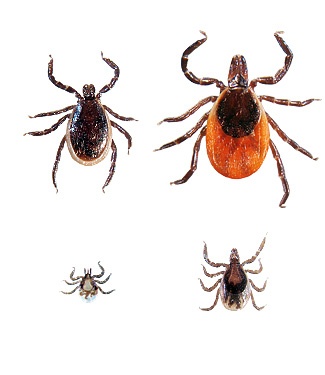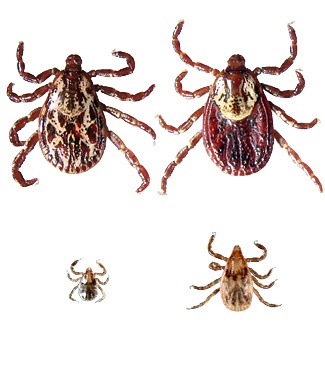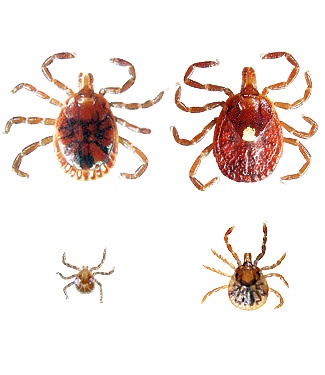
With many of us traveling to Martha's Vineyard this summer, and some lucky ones who live there year-round, it's important to be aware of the tick species on the island and best ways to protect our families so we can enjoy the beautiful beaches, and explore the beautiful New England landscape. Unfortunately, based on the deer density and weather conditions there, the tick populations are active in high numbers, and rates of diseases they carry are on the rise.
Martha's Vineyard Board of Health reported that in 2011, 25% of people ages 5 to 18 have been treated for Tick-Borne illnesses (TBI) one or more times, and 54% reported a family member being treated for TBI. Tourists especially are at risk, as many are not aware of the symptoms and don't seek medical treatment.
The best prevention is awareness. It's hard to tell the difference between tick species, for example deer vs dog ticks, but read on for ways to identify which are on your property, so you can know what to do about it:
1. Blacklegged Tick (a.k.a. Deer Tick)

Black-legged ticks take 2 years to complete their life cycle and are found predominately in deciduous forest. Their distribution relies greatly on the distribution of its reproductive host, white-tailed deer.
Both nymph and adult stages transmit diseases such as Lyme disease, Babesiosis, and Anaplasmosis. (Source: TickEncounter Resource Center)
2. American Dog Tick

American Dog ticks are found predominantly in areas with little or no tree cover, such as grassy fields and scrubland, as well as along walkways and trails. They feed on a variety of hosts, ranging in size from mice to deer, and nymphs and adults can transmit diseases such as Rocky Mountain Spotted Fever and Tularemia.
American dog ticks can survive for up to 2 years at any given stage if no host is found. Females can be identified by their large off-white scutum against a dark brown body. (Source: TickEncounter Resource Center)
3. Lone Star Tick

Lone Star ticks are found mostly in woodlands with dense undergrowth and around animal resting areas. The larvae do not carry disease, but the nymphal and adult stages can transmit the pathogens causing Monocytic Ehrlichiosis, Rocky Mountain Spotted Fever and 'Stari' borreliosis.
Lone Star ticks are notorious pests, and all stages are aggressive human biters. These are new to Martha's Vineyard, and you should report if you see one immediately to the board of health. (Source: TickEncounter Resource Center)
NOTE: If you find a tick on you or a pet, remove it immediately. Seek Care Promptly from Your Primary Care Physician at the First Sign of Symptoms.
Here are on-island treatment options provided by the Martha's Vineyard Board of Health:
Emergency Rooms:
-
- Martha’s Vineyard Hospital
1 Hospital Road
Oak Bluffs
508-693-0410 - Walk-In Clinic for Tick-Related Illnesses
Vineyard Medical Care
304 State Road
Tisbury
508-693-4400 - Island Health Care
245 Edgartown-Vineyard Haven Road
Edgartown
508-939-9358
- Martha’s Vineyard Hospital
Same Day Laboratory Testing for Tick-Borne Illness:
-
- Emergency Room
Martha’s Vineyard Hospital
1 Hospital Road
Oak Bluffs
508-693-0410 - (Includes Western Blot test)
Vineyard Medical Care
304 State Road
Tisbury
508-693-4400
- Emergency Room
Other On-Island Patient Support Centers:
-
- Vineyard Center for Clinical and Diagnostic Research on Tick-Borne Diseases
Vineyard Medical Care
304 State Road
Tisbury
508-687-9520 - Lyme Center of Martha's Vineyard
38A Panhandle Road
West Tisbury
508-693-1846
- Vineyard Center for Clinical and Diagnostic Research on Tick-Borne Diseases
Now that you are identifying the ticks on Martha's Vineyard you are seeing, it's time to protect yourself and others by reducing the overall population and tick habitat near your home. With the right sort of natural tick control treatments, you can do this in ways safe for pets, family and the environment.
Download our free tick identification card, share with your friends, neighbors and family across New England, and contact us for a free consultation to determine the best plan of action to offer season-long protection:


